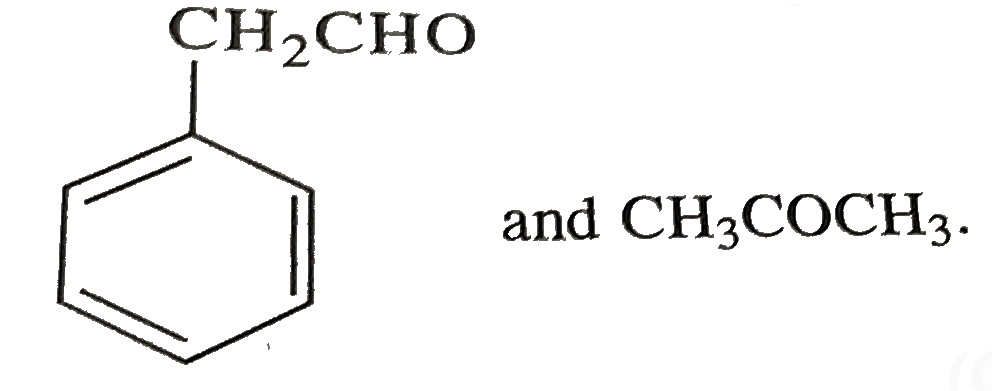Give at least one characteristic test which can distinguish between Chlorobenzene and n-hexylchloride.
To distinguish between chlorobenzene and n-hexyl chloride, we can perform a characteristic test using aqueous KOH and silver nitrate (AgNO3). Here’s a step-by-step solution:
1. Identify the Compounds:
- Chlorobenzene is an aryl halide where a chlorine atom is attached to a benzene ring.
- n-Hexyl chloride is an alkyl halide where a chlorine atom is attached to a straight-chain alkane (hexane).
2. Reactivity of Compounds:
- Alkyl halides (like n-hexyl chloride) are generally more reactive than aryl halides (like chlorobenzene) due to the presence of a partial double bond character in aryl halides, which makes the C-Cl bond stronger.
3. Perform the Test:
- Take a sample of n-hexyl chloride and treat it with aqueous KOH and heat the mixture. The reaction will lead to the substitution of the chlorine atom by a hydroxyl group (OH), resulting in the formation of hexanol.
- The reaction can be represented as:
C6H13Cl+KOHheat−−→C6H13OH+KCl
4. Add Silver Nitrate:
- After the reaction, add a few drops of dilute silver nitrate (AgNO3) solution to the mixture. The presence of KCl will lead to the formation of a white precipitate of silver chloride (AgCl):
KCl+AgNO3→AgCl (s)+KNO3
- The appearance of a white precipitate indicates the presence of n-hexyl chloride.
5. Test Chlorobenzene:
- Now, take a sample of chlorobenzene and treat it with aqueous KOH and heat. Unlike n-hexyl chloride, chlorobenzene will not undergo substitution due to the strong C-Cl bond.
- Therefore, no reaction will occur, and no phenol or KCl will be formed.
6. Add Silver Nitrate to Chlorobenzene:
- When you add silver nitrate to the chlorobenzene solution, there will be no white precipitate formed because no KCl is produced.
Conclusion:
- The formation of a white precipitate of AgCl upon treatment with n-hexyl chloride indicates its presence, while the absence of a precipitate when treating chlorobenzene confirms that it is not an alkyl halide.
- Chlorobenzene is an aryl halide where a chlorine atom is attached to a benzene ring.
- n-Hexyl chloride is an alkyl halide where a chlorine atom is attached to a straight-chain alkane (hexane).
- Alkyl halides (like n-hexyl chloride) are generally more reactive than aryl halides (like chlorobenzene) due to the presence of a partial double bond character in aryl halides, which makes the C-Cl bond stronger.
- Take a sample of n-hexyl chloride and treat it with aqueous KOH and heat the mixture. The reaction will lead to the substitution of the chlorine atom by a hydroxyl group (OH), resulting in the formation of hexanol.
- The reaction can be represented as:
C6H13Cl+KOHheat−−→C6H13OH+KCl
- After the reaction, add a few drops of dilute silver nitrate (AgNO3) solution to the mixture. The presence of KCl will lead to the formation of a white precipitate of silver chloride (AgCl):
KCl+AgNO3→AgCl (s)+KNO3
- The appearance of a white precipitate indicates the presence of n-hexyl chloride.
- Now, take a sample of chlorobenzene and treat it with aqueous KOH and heat. Unlike n-hexyl chloride, chlorobenzene will not undergo substitution due to the strong C-Cl bond.
- Therefore, no reaction will occur, and no phenol or KCl will be formed.
- When you add silver nitrate to the chlorobenzene solution, there will be no white precipitate formed because no KCl is produced.
- The formation of a white precipitate of AgCl upon treatment with n-hexyl chloride indicates its presence, while the absence of a precipitate when treating chlorobenzene confirms that it is not an alkyl halide.
Topper's Solved these Questions
- HALOALKANES AND HALOARENES Book:ICSEChapter:HALOALKANES AND HALOARENES Exercise:EXERCISE (PART - II DESCRIPTIVE QUESTIONS) (LONG ANSWER QUESTIONS)
Explore 65 Videos
- HALOALKANES AND HALOARENES Book:ICSEChapter:HALOALKANES AND HALOARENES Exercise:ISC EXAMINATION QUESTIONS
Explore 4 Videos
- HALOALKANES AND HALOARENES Book:ICSEChapter:HALOALKANES AND HALOARENES Exercise:EXERCISE (PART - II DESCRIPTIVE QUESTIONS) (VERY SHORT ANSWER QUESTIONS)
Explore 83 Videos
- GENERAL PRINCIPLES AND PROCESSES OF ISOLATION OF ELEMENTS Book:ICSEChapter:GENERAL PRINCIPLES AND PROCESSES OF ISOLATION OF ELEMENTS Exercise:EXERCISE (PART-I ( OBJECTIVE QUESTIONS )) (Fill in the blanks)
Explore 60 Videos
- ISC QUESTION PAPERBook:ICSEChapter:ISC QUESTION PAPERExercise:PART-II(SECTION-B)
Explore 74 Videos
Similar Questions
Give at least one characteristic test which can distinguish between Bromobenzene and benzyl bromide.
View SolutionHow will you distinguish between Chlorobenzene and benzyl chloride.
View SolutionHow will you distinguish between Chlorobenzene and n-propyl chloride.
View SolutionGive at least one characteristic test which can distinguish between 1, 1-Dibromoethane and 1,2-dibromoethane.
View SolutionWrite test to distinguish between

View SolutionGive chemical test to distinguish between

View SolutionGive one characteristic test which would distinguish CH4 from C2H2.
View SolutionGive one chemical test to distinguish between the Alkenes and alkynes
View SolutionGive chemical tests to distinguish between:
Propanone and propanal
View SolutionGive a test to distinguish between aldehyde and ketone.
View Solution